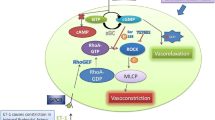Abstract
Improvements in overactive bladder (OAB) symptoms and health-related quality of life (HRQL) were assessed during a 24-week study of tolterodine extended release (TOL ER) in sexually active women with OAB and urgency urinary incontinence (UUI). A 12-week, double-blind, randomized, placebo-controlled trial was followed by a 12-week open-label phase. Sexually active women reported symptoms for ≥3 months. Subjects completed bladder diaries and HRQL measures at baseline and weeks 12 and 24. One hundred sixty-one women received TOL ER for 24 weeks. Women reported significant improvements in all end points at week 12 that were maintained or improved at 24 weeks. At week 24, 70% of subjects reported no UUI episodes. TOL ER resulted in improvements in OAB symptoms and HRQL that were maintained or greater with 6 months of use. Long-term compliance with OAB pharmacotherapy may be important for optimal treatment outcomes.
Similar content being viewed by others
References
Abrams P, Artibani W, Cardozo L, Dmochowski R, van Kerrebroeck P, Sand P (2006) Reviewing the ICS 2002 terminology report: the ongoing debate. Neurourol Urodyn 25:293
Stewart WF, Van Rooyen JB, Cundiff GW, Abrams P, Herzog AR, Corey R, Hunt TL, Wein A (2003) Prevalence and burden of overactive bladder in the United States. World J Urol 20:327–336
Irwin DE, Milsom I, Hunskaar S, Reilly K, Kopp Z, Herschorn S, Coyne K, Kelleher C, Hampel C, Artibani W, Abrams P (2006) Population-based survey of urinary incontinence, overactive bladder, and other lower urinary tract symptoms in five countries: results of the EPIC study. Eur Urol 50:1306–1315
Abrams P, Kellecher CJ, Kerr LA, Rogers RG (2000) Overactive bladder significantly affects quality of life. Am J Manag Care 6:S580–S590
Coyne KS, Margolis MK, Jumadilova Z, Bavendam T, Mueller E, Rogers R (2007) Overactive bladder and women’s sexual health: what is the impact? J Sex Med 4:656–666
Van Kerrebroeck P, Kreder K, Jonas U et al (2001) Tolterodine once-daily: superior efficacy and tolerability in the treatment of the overactive bladder. Urology 57:414–421
Rogers R, Bachmann G, Jumadilova Z, Sun F, Morrow JD, Guan Z, Bavendam T (2008) Efficacy of tolterodine on overactive bladder symptoms and sexual and emotional quality of life in sexually active women. Int J Urogynecol Pelvic Floor Dysfunct 19:1551–1557
Kreder K, Mayne C, Jonas U (2002) Long-term tolerability and efficacy and extended-release tolterodine in the treatment of overactive bladder. Eur Urol 41:588–595
Kelleher CJ, Kreder KJ, Pleil AM et al (2002) Long-term health-related quality of life of patients receiving extended-release tolterodine for overactive bladder. Am J Manag Care 8:S616–S630
Coyne KS, Matza LS, Kopp Z et al (2006) The validation of the Patient Perception of Bladder Condition (PPBC): a single-item global measure for patients with overactive bladder. Eur Urol 49:1079–1086
Coyne K, Revicki D, Hunt T et al (2002) Psychometric validation of an overactive bladder symptom and health-related quality of life questionnaire: the OAB-q. Qual Life Res 11:563–574
Rogers RG, Kammerer-Doak D, Villarreal A, Coates K, Qualls C (2001) A new instrument to measure sexual function in women with urinary incontinence or pelvic organ prolapse. Am J Obstet Gynecol 184:552–558
Symonds T, Boolell M, Quirk F (2005) Development of a questionnaire on sexual quality of life in women. J Sex Marital Ther 31:385–397
Zigmond AS, Snaith RP (1983) The hospital anxiety and depression scale. Acta Psychiatr Scand 67:361–370
Rogers RG, Kammerer-Doak D, Darrow A, Murray K, Olsen A, Barber M, Qualls C (2006) Does sexual function change after surgery for stress urinary incontinence and/or pelvic organ prolapse: a multi-center prospective study. Am J Obstet Gynecol Nov 195(5):e1–4
Baessler K, Stanton SL (2004) Does Burch colposuspension cure coital incontinence? Am J Obstet Gynecol 190:1030–1033
D’Souza AO, Smith MJ, Miller LA, Doyle J, Ariely R (2008) Persistence, adherence and switch rates among extended release overactive bladder medications in a regional managed care plan. J Manag Care Pharm 14(3):291–301
Basra RK, Wagg A, Chapple C, Cardozo L, Castro-Diaz D, Pons ME et al (2008) A review of adherence to drug therapy in patients with overactive bladder. BJU Int 102:774–779
Ouslander JG, Shih YT, Malone-Lee J, Luber K (2000) Overactive bladder: special considerations in the geriatric population. Am J Manag Care 6(11):S599–S606
Acknowledgement
This study was funded by Pfizer Inc.
Conflicts of interest
Gloria Bachmann: Grant/Research Support: Astellas, Wyeth, Bayer, Duramed, Pfizer, Boehringer-Ingelheim, Roche, Merck, QuatRx, Bionovo, Glaxo Smith Kline, Femme Pharma, Hormos, Covance, Novartis, Johnson & Johnson, Boston Scientific, Novonordisk, Procter & Gamble, Xanodyne Consultant: Astellas, Wyeth, Bayer, Duramed, Pfizer, Boehringer-Ingelheim, Roche, Merck, QuatRx, Bionovo, Glaxo Smith Kline, Femme Pharma, Hormos, Covance, Novartis, Johnson & Johnson, Boston Scientific, Novonordisk, Proctor & Gamble, Xanodyne; R Rogers is a consultant, on the speaker’s bureau and has research funding from Pfizer; J Morrow and F Sun are employees of Pfizer. T Omotosho has grant support from Pfizer.
Author information
Authors and Affiliations
Corresponding author
Rights and permissions
About this article
Cite this article
Rogers, R.G., Omotosho, T., Bachmann, G. et al. Continued symptom improvement in sexually active women with overactive bladder and urgency urinary incontinence treated with tolterodine ER for 6 months. Int Urogynecol J 20, 381–385 (2009). https://doi.org/10.1007/s00192-008-0782-9
Received:
Accepted:
Published:
Issue Date:
DOI: https://doi.org/10.1007/s00192-008-0782-9




